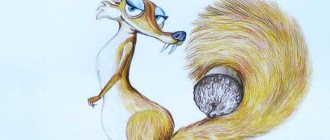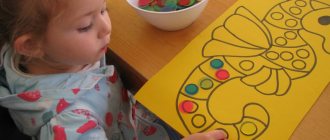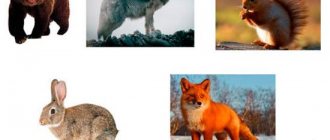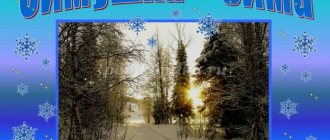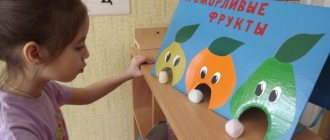Didactic game "Droplet's Journey"
Lomonosova Tatyana Viktorovna
Didactic game "Droplet's Journey"
Didactic game
«Droplet's journey»
This game in an entertaining way promotes the development of cognitive interest, memory, thinking, and speech. The game allows you to feel a sense of responsibility for the state of the environment and understand your role in protecting the environment.
Goal: Development of cognitive interest in the surrounding world, environmental culture.
Tasks:
1. To form ideas about ecological culture, the water cycle in nature, and initial knowledge about sorting waste into classes.
2. Develop the ability to establish cause-and-effect relationships.
3. Foster respect for water.
Description.
Didactic game " Travel of a droplet "
consists of four elements (puzzles that are independent, but united by a common theme. The game set includes small elements (chips, hint cards, pointer arrows, felt-tip pens. The
game is made of materials that allow you to supplement the game with different elements and complicate the tasks. Methodological recommendations :
The proposed game options are designed for individual, subgroup and group activities.
It is better to start the game under the guidance of an adult, gradually complicating the tasks.
Game “Find identical droplets ”
Goal: To develop children's powers of observation and the ability to find similarities and differences in objects. To activate children's vocabulary: different, identical.
Game rule. Select only identical droplets .
Game action. Search for identical droplets .
Progress of the game. The teacher invites the children to look at a puzzle with the image of drops and clouds , a few drops , outside the playing field. The teacher asks to find and apply identical droplets to each other . Among the droplets there may be similar , but not identical.
Complication. Count the number of dots on the droplets .
Game "Collect garbage on Goose Lake"
Goal: To introduce children to the concept of “garbage sorting”, to promote the formation of an environmental culture that you can save water not only by saving it, but also by not clogging it. Develop the ability to classify objects.
Game rule. Determine the material shown on the chip and sort the chips into baskets.
Game action. Sorting chips into baskets.
Progress of the game. The teacher suggests looking at a puzzle with a picture of trash cans and chips on the playing field. Explains the environmental situation: “People came for a picnic to the lake and left garbage behind. Help us sort it into containers: “Paper”
,
“Plastic”
,
“Glass”
,
“Metal”
and
“Food Waste”
.
Complication. Children name objects made from the material shown on the chip before putting them in the basket.
Game "Help Droplets go through the maze"
Goal: To develop visual perception, voluntary attention, fine motor skills. Train determination and perseverance.
Game rule. Draw the desired path with a felt-tip pen.
Game action. Search for the desired track.
Progress of the game. Explain to the child the essence of the game. First, the child must carefully look at the picture. Then he must look for the desired path by tracing it with his finger. And only then can you ask him to draw the desired path with a felt-tip pen; to work with the maze, it is better to give the child an easily erasable felt-tip pen. This will make it easy to correct the mistake and not get confused by incorrectly drawn lines. When working with a felt-tip pen, you need to make sure that the child stops before each turn and thinks through the future path, and does not draw a line at random. It is important, especially at first, to ask the little pioneer to tell him as he moves along why he chose this or that path.
Game “What can you do with water, what can’t?”
Goal: To introduce children to the concept of water conservation, that fresh water is a limited resource; there is a shortage of clean drinking water all over the world. Form in children norms and rules of behavior with water. To encourage children to imagine and be creative, to make them want to make their own contribution to saving clean water.
Progress of the game. Show the signs located on the puzzle, reminiscent of the rules of behavior with water in kindergarten and at home, and invite the children to tell what each sign means. Ask the children why they should act one way or another.
Complication. Children are given the task of coming up with their own rules, and with the help of the teacher they come up with a sign for them. In a given element, an invented sign is depicted; at the initial stage, you can offer to draw it on a larger sign.
Game " Droplet's Journey "
Goal: To develop children’s initial knowledge about the water cycle in nature and its significance.
Progress of the game: Show the clue cards to the children. Offer to determine the properties of water based on the clue cards and the basic senses of a person: nose - smell, eye - vision, lips, tongue - taste, hand - you can touch.
Perform a task:
Smell the water. Can you smell it? (Water has no odor)
Take a sip of water from the glass. Does it taste? (Water has no taste)
Pour water into a transparent glass and place any object. What do we see? (The water is clear)
Touch the water What kind of water is it? (Water is wet)
Invite children to describe what is shown on individual puzzles and place the arrows indicating “ Droplet’s Travels ”
from the cloud further, explaining his choice. At the initial stage, the teacher guides the children and suggests conclusions.
Didactic manual “Speech Clouds”
I approve
Head of MDOU
DS No. 14 “Solnyshko”
______Shevchenko S.V.
Methodological development:
"Didactic aids: "Speech clouds"
Teacher-speech therapist of the municipal preschool educational institution "Kindergarten of a combined type No. 14 "Solnyshko"
Budyonnovsk, Budennovsky district
Dubyagina Inessa Pavlovna
Material posted on social network
education workers
Correct speech is one of the most important conditions for successful personal development. The better a child’s speech is developed, the more complete his communication and interaction with adults and peers. It is very important to take care of the timely formation of children’s speech, its purity and correctness, preventing and correcting various violations. The leading activity of children is play.
Didactic games have a positive effect on the comprehensive development of children and are necessarily included in speech therapy work. When choosing a game, the speech therapist teacher takes into account the age of the children, their psychophysical characteristics, didactic principles, the degree of complexity of the speech disorder, and the stage of speech therapy work.
In practice, I encounter different children, various speech disorders, and we try to select the necessary games for each child individually. Our modern age is good because it provides us with a huge amount of different information, ready-made games, manuals and posters, but they do not always correspond to our wishes and expectations. Therefore, in my work I practice making various games with my own hands.
I bring to your attention didactic manuals for individual and subgroup speech therapy classes on the automation of different sounds, the formation of intonation expressiveness, the development of hand-eye coordination, and so on. These benefits help to diversify the lesson and increase the effectiveness of correctional work.
Goals
:
Automation of sounds [P], [Rb], [L], [L], [S], [Z], [SH], [Z];
Differentiation: [N-W], [W-W], [W-W], [N-W]; [R-R]; [L-L]; [R-L]; [L-R]
Tasks:
- practice isolating a given sound in a word;
-determine the position of the sound;
-learn to differentiate sounds according to deafness - sonority, hardness - softness;
-develop the ability to divide words into syllables;
-develop logical thinking and attention;
- consolidate generalizing concepts in speech;
- develop fine motor skills.
Game options:
Games for automation and differentiation of sounds
.
1. Game “Hard - Soft”.
Purpose: differentiation of sounds
Progress of the game: the child names the picture, determines which sound is “P” (L), or “Rb” (L). Connects it with multi-colored ribbons. At the ends of the ribbons there is a rating: “good”, “cool”.
2. Game “What sound is hidden in the words?”
Target:
differentiation of sounds in words: [R-R]; [L-L]; [R-L]; [L-R]
Progress of the game:
The child names the picture and determines what sound is found in this word “L”, “L” or “R”, “Rb” and attaches a ribbon of a certain color to the picture. At the ends of the ribbons there is a rating: “good”, “cool”, “super”, “cool”.
3. Game “What’s extra?”
Target:
automation of the sound “L” in words, classification of pictures into groups.
Progress of the game:
The child names 4 pictures and connects them with blue ribbons. The speech therapist asks you to name what is unnecessary.
4.Game: “Name everything yellow, red, blue, green.”
Goal: automation of sounds: L, L, R, R.
Progress of the game: the teacher asks the child to name what is yellow, green, blue, red.
5. Game “Deaf - Voiced”
Goal: differentiation: [W-F], [N-W];
Progress of the game: the child names the picture, determines which sound is “S” or “Z”. (Ш or Ж). Gives characteristics to sound. Connects them with a blue or dark blue cloud with ribbons. At the ends of the ribbons there is a rating: “good”, “cool”.
Games to develop and activate vocabulary:
1. Game " Who's Last".
Progress of the game: the teacher and the child select and name in turn one picture with a certain sound that characterizes an object. Whose word will be the last will be the winner.
For example: apple – sweet, green, round, rosy
etc.
2.Game “Compliments”
Progress of the game: choose any picture that you want to “please”, i.e. tell her as many nice words as possible. Compliments can be given in turn: either the speech therapist or the child.
3. Game “Find parts”.
Goal: to improve the ability to correlate signs with their verbal designation.
«This is a plane, what does it have?
" - "
Wings, steering wheel, seats, tail, engine
, etc."
«What does a flower have?
» – «
Stem, root, leaves, petals
…»
4. Game “What Happens?”
Goal: to improve the ability to relate signs to an object.
Progress of the game: The speech therapist names a sign word (adjective), and the child must select several words for it that denote the object (nouns).
We ask the child: “ What is big?”
" - "
House, mountain, elephant ...
" "
What is bigger: an elephant or a mountain?
»
«What is hard?
» – «
Stone, ice, iron...
.»
Or: “What could be blue?
"The child begins to list:
sky, sea, eyes...
Games for the formation of grammatical structure of speech
:
1. Game "One-many"
Purpose: formation of the plural of a noun.
Progress of the game:
Speech therapist: “I have a dog,” and the child should say: “And I have dogs,” etc.
2. Game “Who did you see?”
Goal: differentiation of sounds in words: [R-R]; [L-L]; [R-L]; [L-R]; we teach to use nouns in the accusative case.
Progress of the game: Speech therapist: “We came to the forest and saw...”
. The child names and determines what sound is in this word “R”, “L”, “R”, “L”.
You can play this game using any speech material, while simultaneously expanding your vocabulary: “ We came to the garden and saw... cucumbers, onions, beets, etc.”
3. Games: “Who (what) is missing?”
Goal: teaching the use of nouns in the genitive case: development of visual memory.
How to play: We ask the child to close his eyes and remove one picture. Then we ask: “Who (what) is missing?”
.
4. Game "Guests"
Goal: teach the use of nouns in the dative case
How to play: You can use toys or pictures. The adult begins to say a sentence, and the child finishes it: “The squirrel is going to visit... the hare. The giraffe goes to visit... the zebra"
etc.
5.Game "Big Beast"
Goal: improving word formation skills.
Progress of the lesson: The speech therapist names the picture: “ This is an elephant. Imagine that it is very big. What should we call it?
» Child:
elephant
...
6. Game “Who has who?”
Goal: form the name of the cubs using suffixes.
Progress of the game: The speech therapist names the animal and asks: “Who is the goat (duck, wolf, etc.)?”
The child answers:
“The goat has a kid” (duckling, wolf cub, squirrel cub, etc.).
7. Game “Whose is this?”
Goal: form possessive adjectives
Progress of the game: We ask the following questions: “The beak of the bird - whose beak?”
.
The child answers: “Bird”
.
You can also ask, for example, whose dog’s paw is a dog’s, whose bird’s wings are a bird’s, whose wolf’s tail is a wolf’s, etc.
Games aimed at developing the child’s mental processes:
1. Game “Don’t miss the plant (transport, toy, wild animals)”
Target
: development of voluntary attention, ability to switch attention, phonemic hearing.
Progress of the game:
Children listen and carefully look at the pictures that the speech therapist pronounces. Whenever among the words there are names with the sound “P” ( [Рь], [Л], [Ль], [С], [З], [Ш], [Ф] the guys should clap their hands:
tram, chair...
2. Ball game “Memory”»
Target:
memory development (semantic and mechanical).
Progress of the game:
children stand in a circle. There is a speech therapist in the center. He reads out a couple of words that you need to remember. Then he throws the ball to the child and says the first word. He must name the second and throw the ball to the leader.
MAGAZINE Preschooler.RF
Didactic game “Good Cloud”The author of the didactic manual is teacher-speech therapist Natalya Valerievna Chernysheva.
MUNICIPAL PRE-SCHOOL EDUCATIONAL INSTITUTION "KINDERGARTEN No. 170 TRACTORZAVODSKY DISTRICT OF VOLGOGRAD" 400015, Russia, Volgograd
Goal: to develop the moral consciousness of preschoolers through the development of speech and play activities.
Tasks:
- formation of the foundations of spiritual and moral value orientations in preschool children;
- familiarization with basic generally accepted norms and rules of relationships with peers and adults;
- creating effective conditions for the formation of spirituality and morality in preschool children;
- nurturing respect and love for your family, home, peers, and elders.
- encouraging children to do good to other people.
Age: children 3-7 years old.
Relevance: the game is a favorite activity of children; by completing game tasks, it is easier for the child to independently achieve the goal and develop speech. Currently, the main goal of preschool education is the holistic spiritual and moral development of the child’s personality, including the education of justice, responsibility and other valuable qualities.
I propose to consider options for the game “Good Cloud” used in this direction.
Progress of the game:
A picture of a cloud with ribbons is hung up. The box contains droplets with Velcro.
Option 1. “Favorite quality” .
Goal: to develop in children an understanding of the phenomena of reality from the standpoint of moral and ethical standards.
Ask children to think about their favorite quality. Then, one by one, the children name their favorite quality and this quality is invited to settle on a kind cloud. The child takes a drop and sticks it on the rain.
Option 2. “Circle of Desires” .
Goal: to promote the development of children's speech, communication skills,
thinking. Cultivate peacefulness, a strong desire to do good.
Children take one drop at a time and express their wishes. For example: “I want all evil on the planet to disappear . “I want the kids to come to kindergarten in a good mood , “I want people not to litter,” etc.
Option 3. “Polite words”
Goal: to cultivate in children a culture of behavior, politeness, respect for each other, and a desire to help each other.
Children are asked questions, after the correct answer the cloud gets its drop.
How should you address adults?
What do you say to the person who helped you?
What should you say when you meet someone?
What should you say when leaving home from kindergarten?
What should you say when you wake up in the morning, when you come to kindergarten in the morning?
What words do you say to each other before going to bed?
What is the magic word you say when you want to ask a friend to play with a toy?
What do you say if you accidentally hurt someone? etc.
Children should know and use the words in life: hello, thank you, goodbye, good night, be kind, be kind, please, excuse me, good night, etc.
Equipment: any toy (ball, doll, bear, etc.
This game can be used at the stage of sound automation.
The goal of this stage is the correct pronunciation of sounds in coherent speech. Pronounce sounds in syllables, words, sentences.
Option 4. “Song of a cloud”
Use of onomatopoeia.
Sing the “song of the wind” ssss. “Pump up the pump” ssss.
Ring like a “mosquito” z-z-z.
How the snake hisses sh-sh-sh.
How the beetle buzzes.
How the tiger roars r-r-r.
How the plane hums l-l-l.
When we glue the droplets, at this time we pronounce a certain sound.
Option 5. “Come up with words with sound”
Come up with as many words as possible with automated sound. After each clearly spoken word to a given sound, the droplet sticks to the cloud.
This game can be used at the stage of sound differentiation.
Option 6. “Sound differentiation”
There is sun and thunder on the cloud. The child is offered a set of pictures on clothespins, which contain images with the sounds “S” and “Sh” . “S” to the sun “Sh” to thunder . Similarly, you can differentiate for other pairs of sounds.
| Next > |
LiveInternetLiveInternet
"Magic clouds"
for preschool children.
Description of the material: the manual was made with the aim of developing children's fine motor skills, sensory development, creative imagination, attention, logical thinking, as well as counting skills. Can be used for individual work and for group lessons with children. This manual is multifunctional and consists of felt clouds of various colors with strings attached to them.
Also, the manual includes droplets of different colors, which are made of felt.
Didactic game “Count how many drops? "
Goal: develop counting skills within 10.
Progress of the game: the teacher asks the child to count how many drops are on the cloud. Or place the intended number of drops on the cloud.
Assignment: “How many drops are there on a cloud? ", "Hang 5 drops on a cloud."
Didactic game “Pick the right droplet by color”
Goal: developing the ability to correlate the color of an object.
Progress of the game: the teacher invites the child to look at several clouds and suggests choosing a droplet that matches the color of the cloud. The child completes the task and names the color of the droplet used.
Assignment: “Choose the drop of color you need.”
Didactic game “Correct the mistake”
Goal: development of attention and logical thinking of children.
Progress of the game: the teacher invites the child to look at a cloud with droplets, where among the drops of one color there is one or more drops of a different color.
Assignment: “Find the mistake and correct it.”
Didactic game “Find out where there is more? »
Goal: to develop children’s mental abilities, counting skills, to consolidate the ability to find one or many objects.
Progress of the game: the teacher offers to find out which cloud has more drops by first counting them. For younger preschool children, the teacher places many drops on one cloud, and only one on the other, and asks them to determine where there are many and where there is one drop.
Assignments: “Count the droplets and find out which cloud has more droplets? ", "Look at the clouds and tell where there are many drops and where there is only one."
Didactic game “More - less? »
Goal: to consolidate knowledge about color and size.
Progress of the game: the teacher offers to look at the clouds and say which of them have large drops and which have small ones.
Game option: the teacher suggests correlating the size of the drops with the size of the clouds and placing them accordingly.
Didactic game “Show your imagination”
Goal: development of creativity and imagination.
Progress of the game: the teacher offers tasks: “Dress up the cloud,” “Make the cloud bright and beautiful.” Children use the color scheme of drops of their choice and name the color.
Assignment: “Decorate the cloud with bright droplets and name the colors.”

